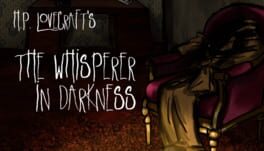

Rumors resurface. Legends are resurrected. In this Lovecraftian visual novel, play as Alex N. Wilmarth, skeptic and professor at Miskatonic University, to unravel the hideous secrets centered at a secluded farm in the hills of Vermont, coming ever closer to mortal peril.
Reviews View More
This is a very hard to rate/review "game" for a few reasons. First, as it's based on a story by Lovecraft, I can't exactly say how much is original and how much isn't. Secondly, I know visual novels tend to have a lot of debate around whether or not they're 'actually games' or not, but this one really pushes that, as not only does all of the text autoscroll, but you get very little choice in the game-- no branching dialogue, no paths or routes, nothing. There's a few segments of top down exploration, but the movement system is just abhorrent and clunky, and to my knowledge, there's not a lot you gain from exploring. But I will say this-- usually visual novels are quite difficult for me to finish because I get bored very easily when reading. This was not a problem here.
The visual presentation of the game is also very interesting. The UI and text, as well as all of the overworld segments are all in this Atari-esque minimalist rectangle pixel style. However, the game also makes use of more detailed paintings to represent certain things that the player is meant to be shown. Note: certain. The book and laptop that we see convey most of the narrative are in the Atari style, while shots of the environment, interiors of rooms, and other focus shots are all hand-drawn. The art itself has an amateurish quality and is displayed at a very low resolution, despite being blown up to fit the screen. And by amateurish, I almost exclusively mean the way that a lot of it looks like unfinished concept art in a lot of ways. It has good understandings of light and object placement, as well as color, but each painting just feels like it was rushed and done in 10 minutes or less. And all the while, it clashes with the art style of the rest of the game. Imagining it in my head, I don't even think that would've been solved had the art been more detailed. If anything, I think it should've all been done in that Atari-style. Using simple blocks and limited color palettes to convey the same things shown in the paintings would've not only fit in with the style more, but also would've been a lot cooler and more unique.
The visual presentation of the game is also very interesting. The UI and text, as well as all of the overworld segments are all in this Atari-esque minimalist rectangle pixel style. However, the game also makes use of more detailed paintings to represent certain things that the player is meant to be shown. Note: certain. The book and laptop that we see convey most of the narrative are in the Atari style, while shots of the environment, interiors of rooms, and other focus shots are all hand-drawn. The art itself has an amateurish quality and is displayed at a very low resolution, despite being blown up to fit the screen. And by amateurish, I almost exclusively mean the way that a lot of it looks like unfinished concept art in a lot of ways. It has good understandings of light and object placement, as well as color, but each painting just feels like it was rushed and done in 10 minutes or less. And all the while, it clashes with the art style of the rest of the game. Imagining it in my head, I don't even think that would've been solved had the art been more detailed. If anything, I think it should've all been done in that Atari-style. Using simple blocks and limited color palettes to convey the same things shown in the paintings would've not only fit in with the style more, but also would've been a lot cooler and more unique.
